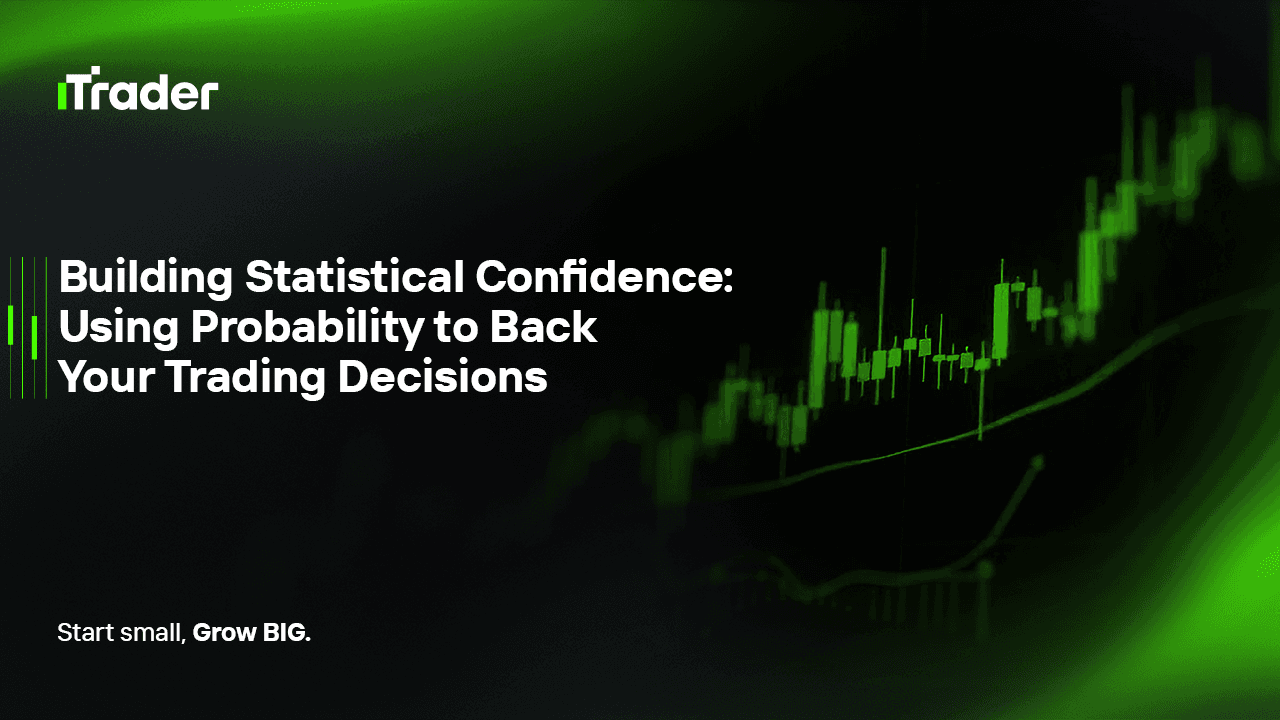2025-10-01
Making decisions in the Forex market often relies on intuition, experience, and market news. However, for consistent long-term success, traders must be able to make decisions with statistical confidence. Relying solely on emotions, temporary signals, or a few successful trades is not enough to pass prop firm evaluations or manage capital effectively.

Statistical methods allow traders to build confidence in their decisions using probability. Rather than trying to predict exactly what will happen in the market, traders can calculate the likelihood of certain outcomes and make systematic, informed decisions.
Probability measures how likely an event is to occur, ranging from impossible to certain. In Forex trading, probability is reflected in strategy win rate, the distribution of outcomes based on risk, and forecasts of strategy performance in various market conditions.
Statistical confidence indicates how reliably results from a sample can be generalized. A strategy may perform well over a period, but that alone does not guarantee future results. Using Confidence Intervals (CI) and hypothesis testing, traders can determine whether outcomes are due to skill or chance.
A Confidence Interval (CI) estimates the range in which the true value of a parameter, such as average strategy return, is likely to lie. It helps distinguish whether good results are systematic or coincidental.
The narrower the CI, the higher the statistical confidence. Narrow intervals indicate a larger sample size or consistent performance. In prop trading, this helps traders decide whether to use a strategy for evaluation, increase capital allocation, or adjust parameters.
Hypothesis testing evaluates whether an assumption is likely true based on probability. In Forex:
The p-value represents the probability of observing results if H₀ is true. A low p-value provides evidence that the strategy’s performance is not random, while a high p-value suggests it may be coincidental.
Each trade is uncertain, but patterns emerge over many trades. Traders can leverage these probabilistic tendencies to gain advantages in prop trading.
For example, if a strategy has a win rate of 55%, risk per trade of 1%, and a reward-to-risk ratio of 1.5:1, the expected return is positive. Applying this strategy over many trades increases statistical confidence, and the Confidence Interval narrows, allowing traders to use the strategy confidently in evaluations and live accounts.
To validate strategy performance, traders should:
Decisions should be made based on statistical confidence rather than intuition.
Prop firms focus on performance stability and risk discipline. By applying statistical methods, traders can:
Statistical validation provides a foundation for assessing a trader’s discipline, consistency, and long-term survivability.
Statistical confidence is not just about calculations; it is about moving from intuition to systematic, probability-based decision-making. Traders who use Confidence Intervals, p-values, and hypothesis testing consistently can maintain adaptability and consistent performance in prop trading and live accounts.
Practical recommendations:
Success in Forex depends not only on finding a winning strategy but also on validating it statistically and executing with confidence. Traders who master these concepts gain the ability to withstand psychological pressure, adapt to changing conditions, and maintain stable performance in prop trading and live accounts.
© 2025 iTrader Global Limited | หมายเลขทะเบียนบริษัท: 15962
iTrader Global Limited ตั้งอยู่ที่ Hamchako, Mutsamudu, เกาะปกครองตนเอง Anjouan, สหภาพคอโมโรส และได้รับใบอนุญาตและอยู่ภายใต้การกำกับดูแลของคณะกรรมการหลักทรัพย์แห่งคอโมโรส ภายใต้หมายเลขใบอนุญาต L15962/ITGL
iTrader Global Limited ดำเนินการภายใต้ชื่อทางการค้า “iTrader” และได้รับอนุญาตให้ดำเนินกิจกรรมการซื้อขายฟอเร็กซ์ โลโก้ เครื่องหมายการค้า และเว็บไซต์ของบริษัทเป็นทรัพย์สินเฉพาะของ iTrader Global Limited
บริษัทย่อยอื่น ๆ ของ iTrader Global Limited ได้แก่ iTrader Global Pty Ltd หมายเลขทะเบียนบริษัทออสเตรเลีย (ACN): 686 857 198 โดยบริษัทนี้เป็นตัวแทนที่ได้รับอนุญาต (หมายเลขตัวแทนบริการทางการเงินของออสเตรเลีย (AFS): 001315037) ของ Opheleo Holdings Pty Ltd (ใบอนุญาตบริการทางการเงินของออสเตรเลีย (AFSL): 000224485) ซึ่งมีที่อยู่จดทะเบียนอยู่ที่ Level 1, 256 Rundle St, Adelaide, SA 5000 ข้อจำกัดความรับผิดชอบ: นิติบุคคลนี้ไม่ใช่ผู้ออก และไม่รับผิดชอบต่อผลิตภัณฑ์ทางการเงินที่ซื้อขายบนหรือผ่านเว็บไซต์นี้
คำเตือนความเสี่ยง: การซื้อขาย CFD มีความเสี่ยงสูงต่อการสูญเสียเงินทุนอย่างรวดเร็วเนื่องจากเลเวอเรจ และอาจไม่เหมาะสมกับผู้ใช้ทุกคน
การซื้อขายกองทุน CFD และผลิตภัณฑ์ที่มีเลเวอเรจสูงอื่น ๆ ต้องการความรู้เฉพาะทาง
จากผลการวิจัยพบว่า 84.01% ของผู้เทรดที่ใช้เลเวอเรจประสบกับการขาดทุน
โปรดตรวจสอบให้แน่ใจว่าคุณเข้าใจความเสี่ยงทั้งหมด และพร้อมที่จะสูญเสียเงินทุนก่อนที่คุณจะเข้าร่วมการซื้อขายที่มีเลเวอเรจ
iTrader ขอประกาศว่า บริษัทจะไม่รับผิดชอบต่อความเสี่ยง ความเสียหาย หรือการสูญเสียใด ๆ ที่เกิดขึ้นจากการซื้อขายแบบมีเลเวอเรจต่อบุคคลหรือนิติบุคคลใด ๆ ทั้งสิ้น
ข่าวสารและข้อมูลที่ปรากฏบนเว็บไซต์นี้มีไว้เพื่อวัตถุประสงค์ทางการศึกษาเท่านั้น ผู้ใช้ควรตัดสินใจทางการเงินอย่างอิสระและโดยใช้ข้อมูลอย่างรอบคอบ
ข้อจำกัด: iTrader ไม่ได้มุ่งเป้าเว็บไซต์หรือบริการไปยังผู้อยู่อาศัยในประเทศที่กฎหมายหรือข้อบังคับห้ามไม่ให้มีการทำธุรกรรมดังกล่าว
หากคุณอาศัยอยู่ในเขตอำนาจที่การใช้เว็บไซต์หรือบริการนี้ถูกจำกัด คุณต้องรับผิดชอบในการปฏิบัติตามกฎหมายท้องถิ่น
iTrader ไม่รับประกันว่าเนื้อหาบนเว็บไซต์ของบริษัทจะเหมาะสมหรือถูกต้องตามกฎหมายในทุกพื้นที่